Ana María Giménez Cerra (Spanish, b.1900-?)
Study of a Fisherman for the painting 'Trabajadores del Mar'', c.1925
Charcoal and coloured chalk on paper
61 x 48 cm
10P C
Further images
-
(View a larger image of thumbnail 1)
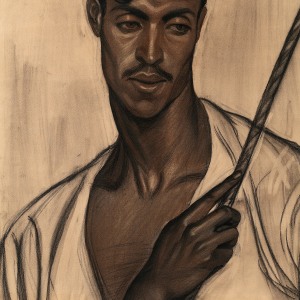
-
(View a larger image of thumbnail 2)
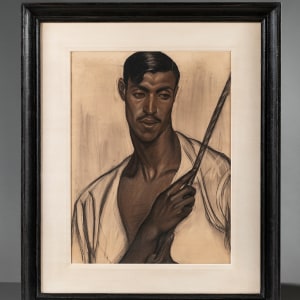
-
(View a larger image of thumbnail 3)
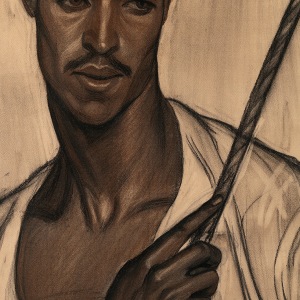
-
(View a larger image of thumbnail 4)
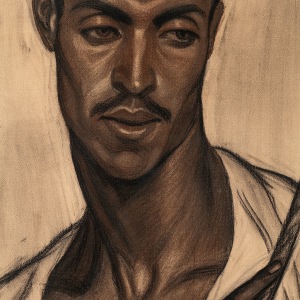
-
(View a larger image of thumbnail 5)
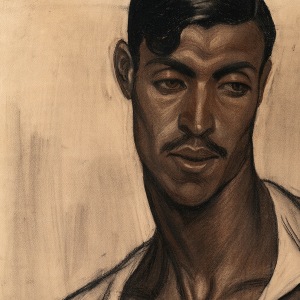
-
(View a larger image of thumbnail 6)
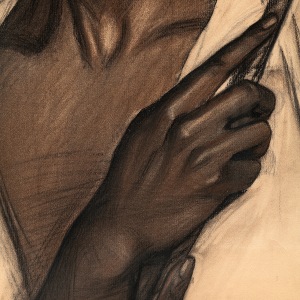
-
(View a larger image of thumbnail 7)
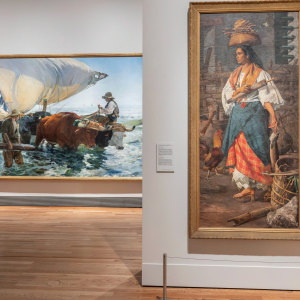
-
(View a larger image of thumbnail 8)
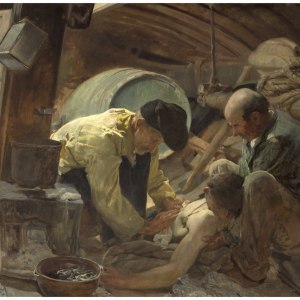
-
(View a larger image of thumbnail 9)
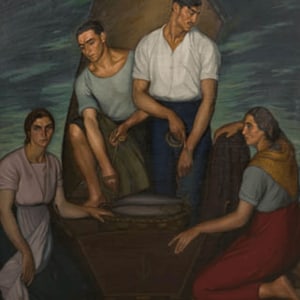
-
(View a larger image of thumbnail 10)
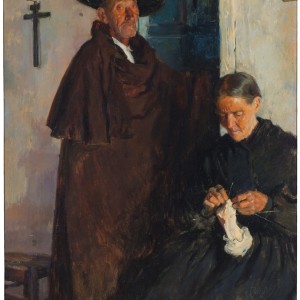
-
(View a larger image of thumbnail 11)
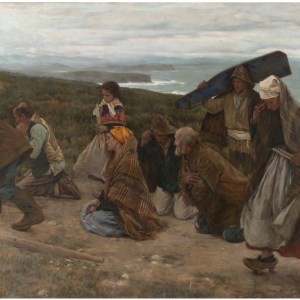
-
(View a larger image of thumbnail 12)
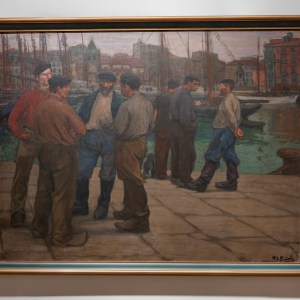
-
(View a larger image of thumbnail 13)
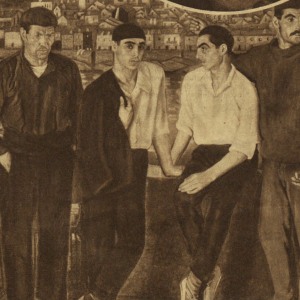
-
(View a larger image of thumbnail 14)
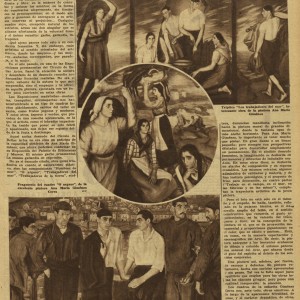
-
(View a larger image of thumbnail 15)
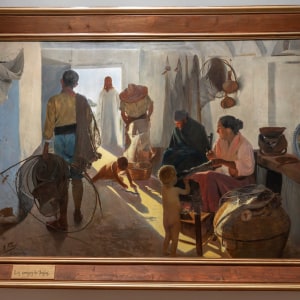
-
(View a larger image of thumbnail 16)
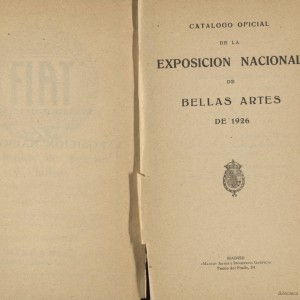
-
(View a larger image of thumbnail 17)
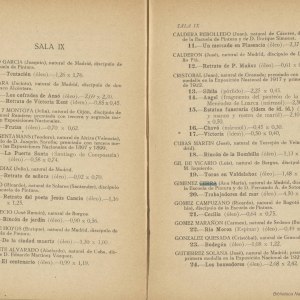
Download the catalogue note as a PDF here. “What remarkable vigour this painter possesses! Vigour in thought, technique, and execution. Vigor in her artistic formation, independent and free; in the...
Download the catalogue note as a PDF here.
“What remarkable vigour this painter possesses! Vigour in thought, technique, and execution. Vigor in her artistic formation, independent and free; in the way she conceives and approaches subjects; in how she resolves them joyfully, without timidity or concerns; in her broad and generous way of giving herself to her art, without reservations or prejudices... Any of her paintings… reveal that singular gift—a fortunate alliance of firm will and determined spirit: elegance, grace, and boldness. How distant all this seems from her feminine condition, and yet, how close it is to the guiding sense of new art, where the greatest—and finest—audacity paradoxically belongs to women.”
La Pintora Ana María Giménez Cerra, exhibition review
Gil Fillol
Ahora Magazine, 1932.
The underrepresentation of female artists in the canon of Western art history, along with the neglect of their contributions, is an ongoing issue that is now receiving increasing attention and efforts at redress. Spain, a vibrant hub of artistic activity in the late 19th and early 20th centuries, is no exception to this discussion. The Prado Museum in Madrid highlighted this with its 2020 exhibition, Invitadas: Fragmentos sobre mujeres, ideología y artes plásticas en España (1833-1931). The role of women artists during this period is also intertwined with a broader reassessment of social painting (cuadro social) from the turn of the 19th and 20th centuries—an area that has historically been overlooked. Notably, despite the acquisition of many significant works from the National Exhibitions of Fine Arts during this period, the Prado had long displayed only one such piece in its galleries—Joaquín Sorolla’s ¡Aún dicen que el pescado es caro! — with the rest remaining in storage. This changed with the museum's 2021 rehang and the subsequent exhibition and catalogue, Arte y Transformaciones Sociales en España: 1885-1910, curated by Javier Barón, which brought these overlooked works and themes into focus. Between the liberal governments of 1885 and 1910, Spain underwent significant transformations that mirrored the broader modernisation occurring across Europe. Artists shifted their focus from historical subjects to contemporary life, resulting in works that vividly captured these societal changes. Influenced by photography, Spanish painters sought greater objectivity in their representation, adopting a naturalistic style similar to that which had gained prominence in France and other countries.
This modernisation not only influenced the evolution of art but also paved the way for increased opportunities for female artists. Changing social attitudes, driven by broader societal reforms and the push for gender equality, facilitated this shift. The focus on contemporary life and everyday scenes in art naturally allowed female artists to depict their own experiences and perspectives in ways that had not been possible before. The advent of photography too, initially considered a minor discipline, further supported this change by promoting greater objectivity and naturalism, thus opening doors for more active participation by women.
Institutional changes also played a critical role. The admission of women into the Real Academia de Bellas Artes de San Fernando in 1910 provided them with new access to formal artistic training. Additionally, the period saw a significant increase in public exhibitions featuring women’s work, including landmark events like the Primera Exposición Feminista held at the Salón Amaré in Madrid in 1903. The establishment of educational institutions such as the Residencia de Señoritas in 1915, which offered university education to women, was also pivotal in advancing women’s education and opportunities in Spain.
Despite these advancements and acknowledging the cultural context of the time, female artists continued to face significant inequality. They often encountered sexist commentary, obstacles to their progress, and a lack of support, which frequently led to their contributions being overlooked. As a result, many, despite their documented formal training and exhibitions, have faded from historical records. Ana María Giménez Cerra exemplifies this issue, with her date of death and later life remaining a mystery despite many documents pertaining to her early life and training. Reviews of the period, including the aforementioned
Although she received notable critical acclaim and press coverage during her lifetime, and studied and exhibited at the prestigious Real Academia de Bellas Artes de San Fernando, Madrid, where she presented four paintings between 1924-34, little is known about her career or life after around 1941 and her date of death is unknown. What little is recorded of her today, aside from first hand historical documents form her time, is noted by Vanesa Hervàs in her 2019 thesis on the professionalisation of female artist in Spain in the early 20th century.
Citing the challenges faced by female entrants to the Bellas Artes, Hervàs quotes Cerra’s contemporary classmate, the designer Victorina Duran, who recalls in her memoirs her treatment by the school’s professor involved with entry and admission exams, Rafael Domenech, stating: “He [Domenech] was not a feminist and detested the female element… At the School, he didn’t believe that any woman could be a painter or sculptor. This led him to confront me aggressively with questions: all were answered until he threw me a question that was almost fatal.”
Despite this prejudice, Cerra achieved success at the Academy, receiving honours and a medal for Artistic Anatomy and a diploma in Ancient Drawing (1919), as well as honours in Decorative Painting, Colour and Composition, Landscapes, Aesthetics of Colour, Drapery, and Drawing from Life (1920-21). However, alongside these accomplishments, on June 10, 1920, she sent a handwritten letter to the Director complaining about the differential treatment of women compared to men at the institution. In 1925-26, she enrolled in the course Drawing from the Nude, and the following year exhibited her painting Trabajadores del Mar, for which the present work is a study. Around this time, she also made copies of Murillo’s Dolorosa and Titian’s Salomé. In 1930, she requested a scholarship to complete her studies in France and Italy; however, she returned to Madrid in January 1931 due to illness. On February 10, 1932, she inaugurated a solo exhibition of paintings, portraits, and drawings at the Sociedad de Amigos del Arte, and although no list of the works has been traced, it is highly likely that the present drawing was included given its relation to her most important painting to date. Overall, between 1924 and 1934 she exhibited four major paintings at the Real Academia de Bellas Artes de San Fernando:
Hombres de mar. 1924. Oil painting (2.38 x 2.91 m). Whereabouts unknown.
Trabajadores del mar. 1926. Oil painting (4.50 x 2.45 m). Whereabouts unknown.
Trabajadores de la tierra. 1932. Painting. Whereabouts unknown.
Trabajadores de la ciudad. 1934. Painting. Whereabouts unknown.
While she continued to exhibit during the 1930s, any trace of her art or person disappears after 1941, and it is unknown what happened to her. It is possible that a recurrence of the illness that halted her scholarship, marriage, or motherhood, or a lack of commercial success and financial security may have contributed to her disappearance from the art world.
Spanish Social Painting: Influences and approach
Cerra's tutor at the Real Academia de Bellas Artes de San Fernando was Fernando Álvarez de Sotomayor (1861–1936), a prominent Spanish painter known for his portraiture and historical scenes. Besides his own artistic achievements, Álvarez de Sotomayor played an important role as a teacher, particularly in mentoring and supporting women artists, including Cerra. His progressive stance on promoting women in the arts, a field dominated by men at the time, was significant. Álvarez de Sotomayor’s mentorship helped shape the careers of many female painters by providing them with opportunities to study and gain recognition during an era when women faced considerable professional barriers.
The theme of the sea and fishermen held significant relevance in the emerging era of Spanish social painting. This focus was not only a reflection of Spain’s extensive coastline but also a response to the nation’s heavy reliance on the fishing industry, making it a popular subject in Spanish art at the turn of the 20th century. Influenced by photography, Spanish painters sought objectivity in their representations, embracing a naturalistic style that celebrated the labor and hardships of the people with a strong sense of national pride. The rise of nationalism during the fin-de-siècle period further fuelled the idea that Spanish artists had an innate ability to depict the world with realism and authenticity. This naturalistic talent was considered a hallmark of Spanish artistic tradition, embodied by masters like Velázquez, Ribera, Zurbarán, and Murillo—whose works from the Golden Age were already internationally acclaimed by this time.
The influence of Velázquez, in particular, was so profound that his paintings dominated among the copyists at the Prado Museum. Joaquín Sorolla emerged as a leading figure in this movement, with iconic works such as La Vuelta de la Pesca and ¡Aún dicen que el pescado es caro! celebrating the lives of fishermen. Other artists followed suit, including Ventura Álvarez Sala (1869-1919), whose La Promesa, después del temporal, Asturias (1903), and Nicanor Piñole (1878-1978), with Marineros en el Puerto de Gijón (1906), further explored the daily struggles of Spain’s coastal communities.
The inclusion of women in the Real Academia de Bellas Artes de San Fernando in 1910 gradually opened doors for female artists to contribute to this tradition. By the 1920s, artists like Cerra were creating works in a similar vein, such as Hombres de mar (1924), which bears a striking resemblance to Piñole’s style, and Trabajadores del mar (1926), for which the present sheet is a preparatory study. These contributions marked an important shift as women artists began to explore and engage with themes that had been predominantly male domains.
The authenticity of this work has been confirmed by Vanesa Villarejo Hervás.
Full transcript of Gil Fillol's review of the exhibition: La Pintora Ana María Giménez Cerra, in Ahora Magazine, 1932:
“What remarkable vigour this painter possesses! Vigour in thought, technique, and execution. Vigour in her artistic formation, independent and free; in the way she conceives and approaches subjects; in how she resolves them joyfully, without timidity or concerns; in her broad and generous way of giving herself to her art, without reservations or prejudices... Any of her paintings, with the natural exception of portraits, reveals that singular gift—a fortunate alliance of firm will and determined spirit: elegance, grace, and boldness. How distant all this seems from her feminine condition, and yet, how close it is to the guiding sense of new art, where the greatest—and finest—audacity paradoxically belongs to women.
Last year, at one of the permanent exhibitions at the Círculo de Bellas Artes, the ease and boldness of a nude painting resolved with unusual realistic liberties drew attention. It wasn't the artist’s brave gesture that surprised most, but rather the bearing and pride of that painting, executed with an uncommon fervour in such works. Madrid exhibitions—modest, calm, circumspect—have accustomed us to a type of painting done placidly, emerging from the studio in due season, like juicy, ripe fruit. And these other works, rough and green, which come from a rushed harvest where the artist, like the impatient farmer, had to infuse his feverish and passionate zeal, leave us with the sour aftertaste of fruit picked too early.
That bold nude at the Círculo de Bellas Artes was merely a preview of Ana María Giménez’s pictorial capacity, which we can now confirm in her exhibition at the Palace of Libraries and Museums. The same ornamental grace. The same expressive gallantry. Not just the aforementioned nude, perhaps thoughtless in terms of plastic naturalism, but also compositions like "Men of the Sea," "Seaweed," "Workers of the Sea," "Workers of the Land," etc. The triptych "Workers of the Sea," an interesting work by the painter Ana María Giménez, reveals a clear inclination toward large-scale mural painting, where imagination enjoys a broader horizon.
For Ana María Giménez, what matters is having much to paint. A large canvas or a small one; but always with expansive perspectives to fully develop a thought. In the aforementioned female nude, imagination overflows with details and minutiae of undeniable rawness. In these other oils, it overflows with compositional displays and chromatic richness. Even the portraits, some admirable in quality and substance, with a fine psychological instinct, and the frieze project for decoration in four parts ("Work in the fields, at sea, in factories, and in mines"), complete the artistic trajectory of the young painter.
But vigour is not only in size and effort. It is also reflected in technical strength, in the broad development of the theme, in the constructive sense that recalls an architectural taste; in the courage of the stroke, serious and hard; in the conception of the painting itself, which is of monumental projection and gigantic proportions; in the colour, which is warm and thick... In short, it is in the spectacular and theatrical manner of Art. That is to say, the painter prioritises the extensive sensual panorama of Art—encompassing from the enjoyment of the spirit to the delight of the bodily senses—over the innocent arabesques of drawing and colour. Such painting inevitably suffers from excesses and defects. It is vehement painting, made with hurried caresses and without pause. It may lack the precise balance that Greek canons demanded for beautiful works, but it possesses an unsurpassable quality: emotion. The paintings of Miss Giménez Cerra are, above all, emotional works. Throughout the apparent frivolity of some and the dramatic character of others, a scale of emotions runs through. Once sensitivity is captured, the absolute correctness of the lines, the academic refinements, or the exact measure and weight of colour values no longer matter as much. The truly manly vigour with which they are painted and felt is the best compensation for the deficiencies that a severe critical spirit might find in those works by the Sociedad Amigos del Arte, executed with enthusiasm and resolved with grace and gallantry.”
Fig.1. Installation shot of the exhibition, Arte y Transformaciones Sociales en España: 1885-1910, curated by Javier Barón, Prado Museum, Madrid, 2024, with Joaquin Sorolla’s La Vuelta de la Pesca, from 1894 in the background.
Fig.2. Joaquin Sorolla, ¡Aún dicen que el pescado es caro! (And they still say Fish is expensice!), 1894, Oil on Canvas, Museo del Prado, Madrid
Fig. 3. Fernando Álvarez de Sotomayor (1861–1936), The Grandparents, oil on canvas, Museo del Prado, Madrid
Fig. 4. Ana Maria Gimenez Cerra (b.1900), Trabajadores del Mar, 1926, oil on canvas, location unknown, exhibited in 1926 Real Academia de Bellas Artes de San Fernando, Madrid
Fig.5. Álvarez Sala (1869-1919), La Promesa, después del temporal, Asturias, 1903, Museo del Prado, Madrid
Fig.6. Nicanor Piñole (1878-1978), with Marineros en el Puerto de Gijón, 1906
Fig.7. Ahora Magazine, La Pintora Ana María Giménez Cerra, Exhibition Review by Gil Fillol, 1932
“What remarkable vigour this painter possesses! Vigour in thought, technique, and execution. Vigor in her artistic formation, independent and free; in the way she conceives and approaches subjects; in how she resolves them joyfully, without timidity or concerns; in her broad and generous way of giving herself to her art, without reservations or prejudices... Any of her paintings… reveal that singular gift—a fortunate alliance of firm will and determined spirit: elegance, grace, and boldness. How distant all this seems from her feminine condition, and yet, how close it is to the guiding sense of new art, where the greatest—and finest—audacity paradoxically belongs to women.”
La Pintora Ana María Giménez Cerra, exhibition review
Gil Fillol
Ahora Magazine, 1932.
The underrepresentation of female artists in the canon of Western art history, along with the neglect of their contributions, is an ongoing issue that is now receiving increasing attention and efforts at redress. Spain, a vibrant hub of artistic activity in the late 19th and early 20th centuries, is no exception to this discussion. The Prado Museum in Madrid highlighted this with its 2020 exhibition, Invitadas: Fragmentos sobre mujeres, ideología y artes plásticas en España (1833-1931). The role of women artists during this period is also intertwined with a broader reassessment of social painting (cuadro social) from the turn of the 19th and 20th centuries—an area that has historically been overlooked. Notably, despite the acquisition of many significant works from the National Exhibitions of Fine Arts during this period, the Prado had long displayed only one such piece in its galleries—Joaquín Sorolla’s ¡Aún dicen que el pescado es caro! — with the rest remaining in storage. This changed with the museum's 2021 rehang and the subsequent exhibition and catalogue, Arte y Transformaciones Sociales en España: 1885-1910, curated by Javier Barón, which brought these overlooked works and themes into focus. Between the liberal governments of 1885 and 1910, Spain underwent significant transformations that mirrored the broader modernisation occurring across Europe. Artists shifted their focus from historical subjects to contemporary life, resulting in works that vividly captured these societal changes. Influenced by photography, Spanish painters sought greater objectivity in their representation, adopting a naturalistic style similar to that which had gained prominence in France and other countries.
This modernisation not only influenced the evolution of art but also paved the way for increased opportunities for female artists. Changing social attitudes, driven by broader societal reforms and the push for gender equality, facilitated this shift. The focus on contemporary life and everyday scenes in art naturally allowed female artists to depict their own experiences and perspectives in ways that had not been possible before. The advent of photography too, initially considered a minor discipline, further supported this change by promoting greater objectivity and naturalism, thus opening doors for more active participation by women.
Institutional changes also played a critical role. The admission of women into the Real Academia de Bellas Artes de San Fernando in 1910 provided them with new access to formal artistic training. Additionally, the period saw a significant increase in public exhibitions featuring women’s work, including landmark events like the Primera Exposición Feminista held at the Salón Amaré in Madrid in 1903. The establishment of educational institutions such as the Residencia de Señoritas in 1915, which offered university education to women, was also pivotal in advancing women’s education and opportunities in Spain.
Despite these advancements and acknowledging the cultural context of the time, female artists continued to face significant inequality. They often encountered sexist commentary, obstacles to their progress, and a lack of support, which frequently led to their contributions being overlooked. As a result, many, despite their documented formal training and exhibitions, have faded from historical records. Ana María Giménez Cerra exemplifies this issue, with her date of death and later life remaining a mystery despite many documents pertaining to her early life and training. Reviews of the period, including the aforementioned
Although she received notable critical acclaim and press coverage during her lifetime, and studied and exhibited at the prestigious Real Academia de Bellas Artes de San Fernando, Madrid, where she presented four paintings between 1924-34, little is known about her career or life after around 1941 and her date of death is unknown. What little is recorded of her today, aside from first hand historical documents form her time, is noted by Vanesa Hervàs in her 2019 thesis on the professionalisation of female artist in Spain in the early 20th century.
Citing the challenges faced by female entrants to the Bellas Artes, Hervàs quotes Cerra’s contemporary classmate, the designer Victorina Duran, who recalls in her memoirs her treatment by the school’s professor involved with entry and admission exams, Rafael Domenech, stating: “He [Domenech] was not a feminist and detested the female element… At the School, he didn’t believe that any woman could be a painter or sculptor. This led him to confront me aggressively with questions: all were answered until he threw me a question that was almost fatal.”
Despite this prejudice, Cerra achieved success at the Academy, receiving honours and a medal for Artistic Anatomy and a diploma in Ancient Drawing (1919), as well as honours in Decorative Painting, Colour and Composition, Landscapes, Aesthetics of Colour, Drapery, and Drawing from Life (1920-21). However, alongside these accomplishments, on June 10, 1920, she sent a handwritten letter to the Director complaining about the differential treatment of women compared to men at the institution. In 1925-26, she enrolled in the course Drawing from the Nude, and the following year exhibited her painting Trabajadores del Mar, for which the present work is a study. Around this time, she also made copies of Murillo’s Dolorosa and Titian’s Salomé. In 1930, she requested a scholarship to complete her studies in France and Italy; however, she returned to Madrid in January 1931 due to illness. On February 10, 1932, she inaugurated a solo exhibition of paintings, portraits, and drawings at the Sociedad de Amigos del Arte, and although no list of the works has been traced, it is highly likely that the present drawing was included given its relation to her most important painting to date. Overall, between 1924 and 1934 she exhibited four major paintings at the Real Academia de Bellas Artes de San Fernando:
Hombres de mar. 1924. Oil painting (2.38 x 2.91 m). Whereabouts unknown.
Trabajadores del mar. 1926. Oil painting (4.50 x 2.45 m). Whereabouts unknown.
Trabajadores de la tierra. 1932. Painting. Whereabouts unknown.
Trabajadores de la ciudad. 1934. Painting. Whereabouts unknown.
While she continued to exhibit during the 1930s, any trace of her art or person disappears after 1941, and it is unknown what happened to her. It is possible that a recurrence of the illness that halted her scholarship, marriage, or motherhood, or a lack of commercial success and financial security may have contributed to her disappearance from the art world.
Spanish Social Painting: Influences and approach
Cerra's tutor at the Real Academia de Bellas Artes de San Fernando was Fernando Álvarez de Sotomayor (1861–1936), a prominent Spanish painter known for his portraiture and historical scenes. Besides his own artistic achievements, Álvarez de Sotomayor played an important role as a teacher, particularly in mentoring and supporting women artists, including Cerra. His progressive stance on promoting women in the arts, a field dominated by men at the time, was significant. Álvarez de Sotomayor’s mentorship helped shape the careers of many female painters by providing them with opportunities to study and gain recognition during an era when women faced considerable professional barriers.
The theme of the sea and fishermen held significant relevance in the emerging era of Spanish social painting. This focus was not only a reflection of Spain’s extensive coastline but also a response to the nation’s heavy reliance on the fishing industry, making it a popular subject in Spanish art at the turn of the 20th century. Influenced by photography, Spanish painters sought objectivity in their representations, embracing a naturalistic style that celebrated the labor and hardships of the people with a strong sense of national pride. The rise of nationalism during the fin-de-siècle period further fuelled the idea that Spanish artists had an innate ability to depict the world with realism and authenticity. This naturalistic talent was considered a hallmark of Spanish artistic tradition, embodied by masters like Velázquez, Ribera, Zurbarán, and Murillo—whose works from the Golden Age were already internationally acclaimed by this time.
The influence of Velázquez, in particular, was so profound that his paintings dominated among the copyists at the Prado Museum. Joaquín Sorolla emerged as a leading figure in this movement, with iconic works such as La Vuelta de la Pesca and ¡Aún dicen que el pescado es caro! celebrating the lives of fishermen. Other artists followed suit, including Ventura Álvarez Sala (1869-1919), whose La Promesa, después del temporal, Asturias (1903), and Nicanor Piñole (1878-1978), with Marineros en el Puerto de Gijón (1906), further explored the daily struggles of Spain’s coastal communities.
The inclusion of women in the Real Academia de Bellas Artes de San Fernando in 1910 gradually opened doors for female artists to contribute to this tradition. By the 1920s, artists like Cerra were creating works in a similar vein, such as Hombres de mar (1924), which bears a striking resemblance to Piñole’s style, and Trabajadores del mar (1926), for which the present sheet is a preparatory study. These contributions marked an important shift as women artists began to explore and engage with themes that had been predominantly male domains.
The authenticity of this work has been confirmed by Vanesa Villarejo Hervás.
Full transcript of Gil Fillol's review of the exhibition: La Pintora Ana María Giménez Cerra, in Ahora Magazine, 1932:
“What remarkable vigour this painter possesses! Vigour in thought, technique, and execution. Vigour in her artistic formation, independent and free; in the way she conceives and approaches subjects; in how she resolves them joyfully, without timidity or concerns; in her broad and generous way of giving herself to her art, without reservations or prejudices... Any of her paintings, with the natural exception of portraits, reveals that singular gift—a fortunate alliance of firm will and determined spirit: elegance, grace, and boldness. How distant all this seems from her feminine condition, and yet, how close it is to the guiding sense of new art, where the greatest—and finest—audacity paradoxically belongs to women.
Last year, at one of the permanent exhibitions at the Círculo de Bellas Artes, the ease and boldness of a nude painting resolved with unusual realistic liberties drew attention. It wasn't the artist’s brave gesture that surprised most, but rather the bearing and pride of that painting, executed with an uncommon fervour in such works. Madrid exhibitions—modest, calm, circumspect—have accustomed us to a type of painting done placidly, emerging from the studio in due season, like juicy, ripe fruit. And these other works, rough and green, which come from a rushed harvest where the artist, like the impatient farmer, had to infuse his feverish and passionate zeal, leave us with the sour aftertaste of fruit picked too early.
That bold nude at the Círculo de Bellas Artes was merely a preview of Ana María Giménez’s pictorial capacity, which we can now confirm in her exhibition at the Palace of Libraries and Museums. The same ornamental grace. The same expressive gallantry. Not just the aforementioned nude, perhaps thoughtless in terms of plastic naturalism, but also compositions like "Men of the Sea," "Seaweed," "Workers of the Sea," "Workers of the Land," etc. The triptych "Workers of the Sea," an interesting work by the painter Ana María Giménez, reveals a clear inclination toward large-scale mural painting, where imagination enjoys a broader horizon.
For Ana María Giménez, what matters is having much to paint. A large canvas or a small one; but always with expansive perspectives to fully develop a thought. In the aforementioned female nude, imagination overflows with details and minutiae of undeniable rawness. In these other oils, it overflows with compositional displays and chromatic richness. Even the portraits, some admirable in quality and substance, with a fine psychological instinct, and the frieze project for decoration in four parts ("Work in the fields, at sea, in factories, and in mines"), complete the artistic trajectory of the young painter.
But vigour is not only in size and effort. It is also reflected in technical strength, in the broad development of the theme, in the constructive sense that recalls an architectural taste; in the courage of the stroke, serious and hard; in the conception of the painting itself, which is of monumental projection and gigantic proportions; in the colour, which is warm and thick... In short, it is in the spectacular and theatrical manner of Art. That is to say, the painter prioritises the extensive sensual panorama of Art—encompassing from the enjoyment of the spirit to the delight of the bodily senses—over the innocent arabesques of drawing and colour. Such painting inevitably suffers from excesses and defects. It is vehement painting, made with hurried caresses and without pause. It may lack the precise balance that Greek canons demanded for beautiful works, but it possesses an unsurpassable quality: emotion. The paintings of Miss Giménez Cerra are, above all, emotional works. Throughout the apparent frivolity of some and the dramatic character of others, a scale of emotions runs through. Once sensitivity is captured, the absolute correctness of the lines, the academic refinements, or the exact measure and weight of colour values no longer matter as much. The truly manly vigour with which they are painted and felt is the best compensation for the deficiencies that a severe critical spirit might find in those works by the Sociedad Amigos del Arte, executed with enthusiasm and resolved with grace and gallantry.”
Fig.1. Installation shot of the exhibition, Arte y Transformaciones Sociales en España: 1885-1910, curated by Javier Barón, Prado Museum, Madrid, 2024, with Joaquin Sorolla’s La Vuelta de la Pesca, from 1894 in the background.
Fig.2. Joaquin Sorolla, ¡Aún dicen que el pescado es caro! (And they still say Fish is expensice!), 1894, Oil on Canvas, Museo del Prado, Madrid
Fig. 3. Fernando Álvarez de Sotomayor (1861–1936), The Grandparents, oil on canvas, Museo del Prado, Madrid
Fig. 4. Ana Maria Gimenez Cerra (b.1900), Trabajadores del Mar, 1926, oil on canvas, location unknown, exhibited in 1926 Real Academia de Bellas Artes de San Fernando, Madrid
Fig.5. Álvarez Sala (1869-1919), La Promesa, después del temporal, Asturias, 1903, Museo del Prado, Madrid
Fig.6. Nicanor Piñole (1878-1978), with Marineros en el Puerto de Gijón, 1906
Fig.7. Ahora Magazine, La Pintora Ana María Giménez Cerra, Exhibition Review by Gil Fillol, 1932
Provenance
Private Collection, Madrid, until 2024Exhibitions
Possibly, Madrid, Sociedad de Amigos del Arte, Palacio de la Biblioteca Nacional, 'Ana María Giménez Cerra: Cuadros, retratos y dibujos', February 1932This is a study for the main figure of a fisherman in Cerra's 1926 painting 'Trabajadores del Mar,' which was exhibited at the Exposicion Nacional de Bellas Artes, Madrid, 1926, no. 20 (Sala IX)
Literature
For a overview on early 20th century female artists working in Spain, and a biographical note on Cerra's life see: Villarejo Hervás, Vanesa. (2019). "Adorno" y profesionalización artística femenina. El caso de la Escuela Especial de Pintura, Escultura y Grabado de Madrid desde un enfoque histórico-social y con perspectiva de género. Breve historia de un olvido reconocido (1903-1936). [Translation: Adornment and the Professionalization of Women Artists: A Historical-Social and Gender Perspective on the Special School of Painting, Sculpture, and Engraving in Madrid. A Brief History of a Recognized Oversight (1903-1936).]Montagut, E. (2020). Sexism and art criticism in the working class press in the case of Ana Maria Gimenez Cerra (1932). BMN Magazine no 9, Jan 2021.
















